
The Bottom Line
Introduction, Specifications, and Pricing
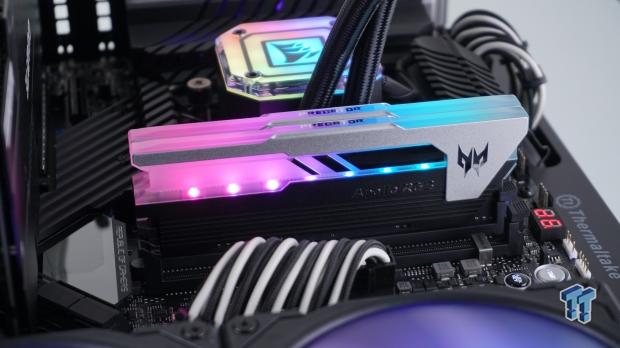
Many in the PC game will say that DDR4 is on its way out, but the pile of samples we have on-hand says otherwise. While we cannot argue that DDR5 is right around the corner, that fact is not stopping manufacturers from coming out of left field with something new. In this instance, we have a significant corporation like Acer, which has decided, like many others, to enter the aftermarket RAM game. In our emails with the third-party representatives, we were asked not to call this kit Acer anything, as they have used their Predator Series name and ran with it into a new site called predatorstorage.com where you will see M.2 drives, DDR4 with heat spreaders, and another section for RGB memory, of which we have the only current sample.
Viewing this new webpage, Predator's main features are listed as the use of Samsung B-die, which is a huge selling point to many, especially those on AMD systems. They have a huge range of speeds from 3200 to 5000 MHz as options. Predator mentions 15-micron gold-plated contacts, and last, that they come with a limited lifetime warranty. For a fresh upstart into this market, all signs are pointing to these sticks being well worth your attention, as it appears they did not skimp on anything to make their entry and garnish a portion of what is an already flooded market. On top of the basics, we also have a set of RAM that comes with impressive-looking heat spreaders and deliver RGB lighting, which is compatible with many motherboard RGB Sync systems and should be an attractive addition to any system.
In the kit of Predator Apollo RGB RAM that we have currently, we expect good things, as not only is the speed reasonable, but the tight timings also allude to top-tier performance. However, with RAM prices increasing every day, you will be shelling out a fair bit of cash to obtain such a kit. Not only that, but these Predator sticks will play well on any DDR4 system with a capable IMC and leave you wanting very little when it comes to the results with XMP and DOCP profiles.
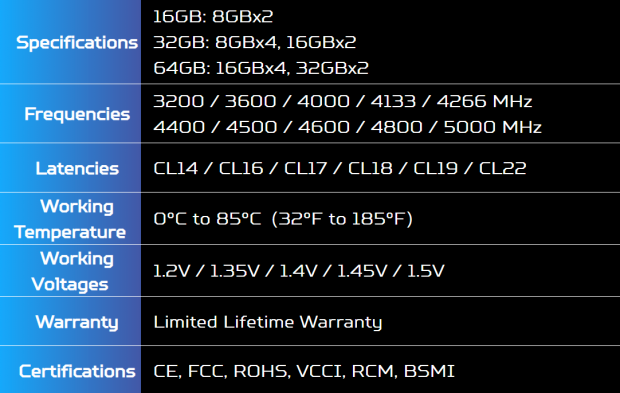
Predator provides this chart on their product page, and we start the list with density, where we find that these kits are available in 16GB, 32GB, and 64GB kits, the latter two with 2-stick or 4-stick options. Predator also offers an expansive range of speeds from 3200 MHz to 5000 MHz in ten steps between the two. CAS latency depends on the speed of the kit, but what we can say for sure is that the 3200 MHz and 3600MHz are available with CAS14, and the faster you go, the closer to CAS22 you will get. The thermal rating for these ICs is up to 85°C, and that temperature will vary depending on the VDIMM, which ranges from 1.2V on the lower speed kits, and up to 1.5V for the upper range. As many RAM makers do, Predator also offers a Limited Lifetime warranty.
For testing, the specific set with the part number BL.9BWWB.253 and is a 16GB set of 3600 MHz DDR4. The timings of our kit are 14-15-15-35, and to achieve those speeds and timings, Predator set the VDIMM to 1.45V. As mentioned on the product page, this is a Samsung B-die-based set of RAM, but not the coveted straight-timings stuff. Beyond the speed, voltage, and speeds, we also get aggressively styled metal heat spreaders that sport the Acer Predator logo on the sides, with a tall RGB diffuser, which is compatible with all of the significant Sync software suites from motherboard manufacturers.
While we are currently unable to find an active listing of the Predator Apollo RGB, we know that RAM with similar specs costs, at minimum, $185, while most of the options are much closer to $240 on average. Many of the options are G.Skill kits, with an occasional Corsair or XPG kit in the mix. Judging by the MSRP) of $249.99 of the Predator Apollo RGB, they think highly of this kit and come out swinging at a price that the best of the best offer solutions at. That being said, it will come down to testing to sort out the value, as appearance and specifications allude to this being a kit worth your attention, but how deep into your wallet this set of Predator Apollo RGB is requiring, they have set the bar relatively high before we even open the box.

Packaging and Predator Apollo RGB
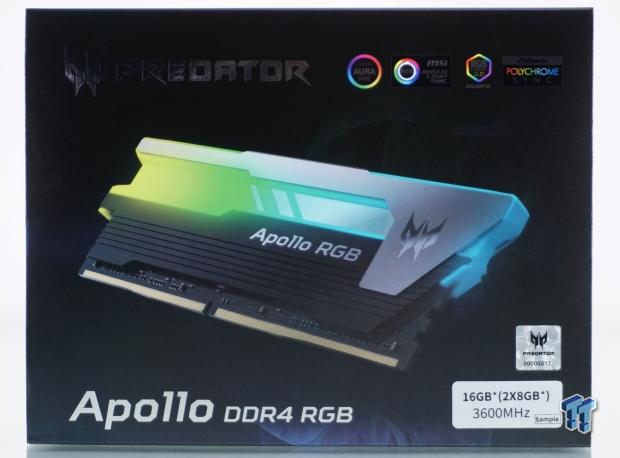
Our Predator Apollo RGB shipped in a matte black package, which shows wisps of smoke behind the image of the illuminated stick centered in this panel. Across the top is the Predator name and logo in foil letters, followed by the various sync methods capable of controlling the RGB LEDs. Across the bottom is the Apollo DDR4 RGB product name, followed by a holographic Predator sticker with the serial number and another box showing the density and speed of the kit inside.
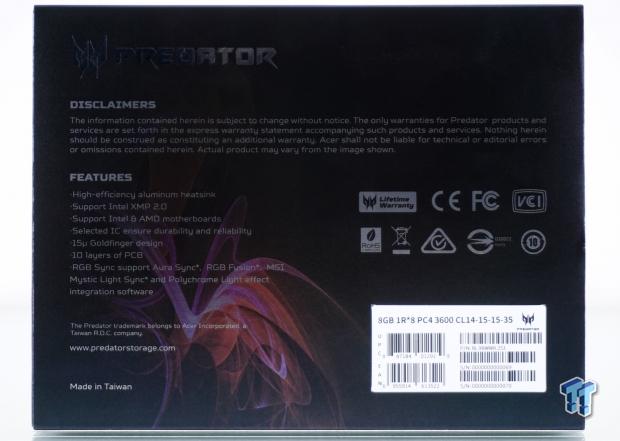
The color of the wisps of smoke has changed on the matte black back panel, but we start again with the foil letters spelling out the manufacturer name and is used for the logo. We begin with disclaimers like information may change and that Predator is not liable for technical or editorial errors. Beyond that is a complete list of features, where we see that these contain aluminum heat spreaders, support of XMP and DOCP, ICs are screened for reliability, and there is a 10-layer PCB. The rest of the features have already been covered. Lastly, we find the company information and compliances and a white section where the density, speed, and timings are shown and the part number for this packaged RAM.
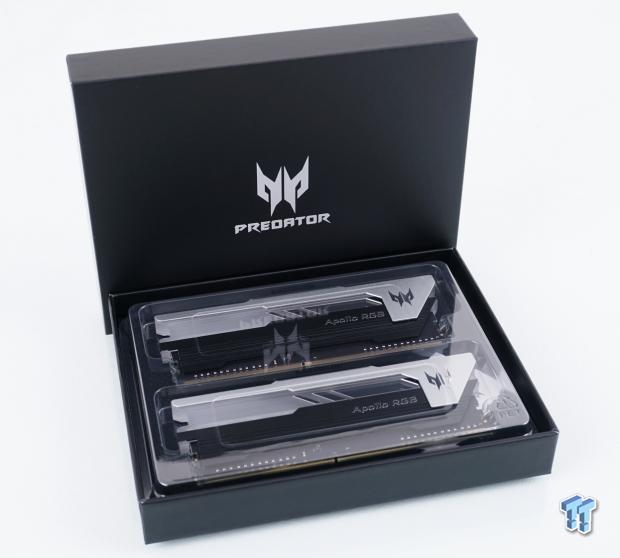
We have previously seen a thin sleeve covering high-end packaging inside, which is what we see in the above image. The top of the thick cardboard box sports the Predator name and logo, and once removed, exposed the clamshell packaging resting on a thick foam layer to keep the packaging at the top. With a premium price associated with this kit, it is heartwarming to see that Predator took notes from the likes of G.Skill, and proved users with an experience that is much better than what we get in the average sample of DDR4.
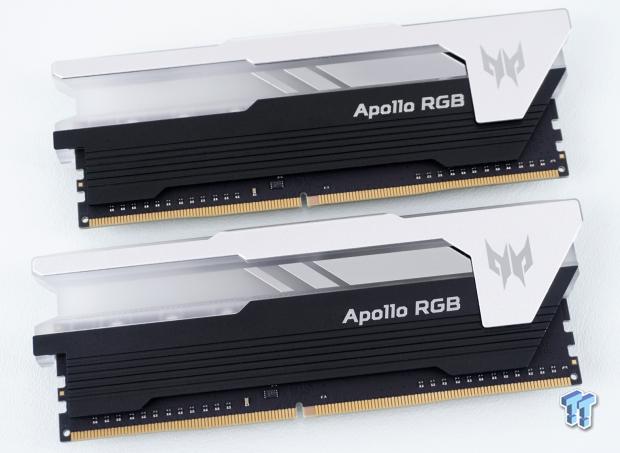
Fresh out of any packaging, our Predator Apollo RGB is on full display. Not only does Predator use a black, 10-layer PCB, but they took the time to design an aluminum heat spreader like no other. The black portion is thick, with horizontal grooves machined into each side, where we find Apollo RGB painted on them near the top. Above the heat spreader is a tall diffusion bar, which has metallic stickers applied and has a silver-colored top cover similarly sporting a logo as we found on the packaging, but this time is shiny and metal, not made from foil.
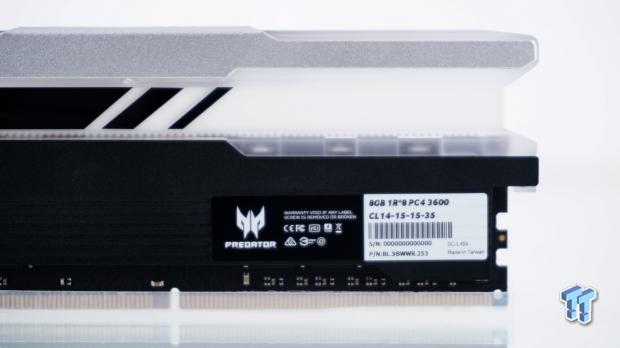
On the other side of both sticks, very close to the right end of each, is where the product sticker is found. On it, we see that this is an 8GB stick of PC4 3600 MHz RAM, with 14-15-15-35 timings, and even though we see the BL.9BWWR.253 part number, the serial number has been left at all zeros with our sample of them. While not as obvious, along with the kit being made in Taiwan, they require 1.45V for XMP/DOCP operation.
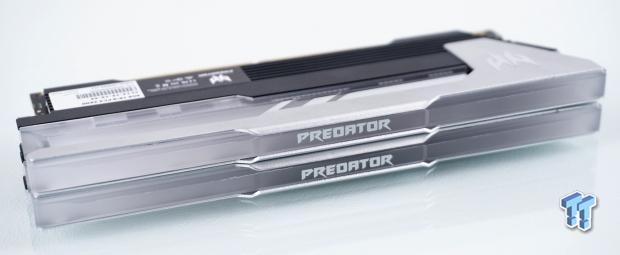
The silver sections of the spreaders surrounding the diffusion bar on the sides also wrap around to the top, but only in the center. They are shaped to add a bit more style while leaving the entire top portion of the diffuser open to the world. The same white paint we saw on the sides of the sticks is used to display the manufacturer at the top but is otherwise a stripe of milky white plastic until you boot your system.
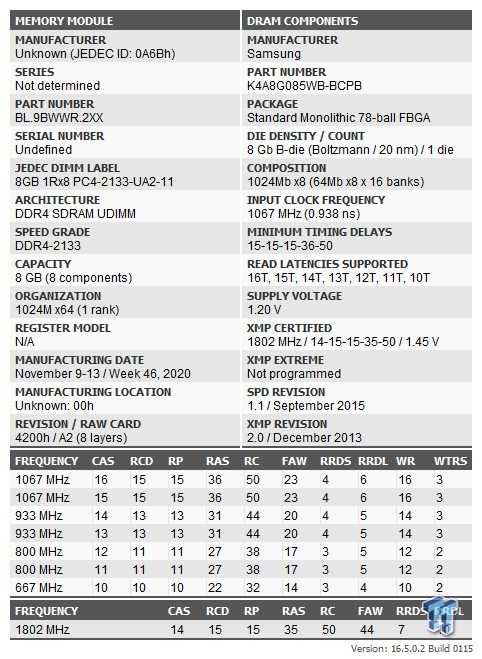
Rather than pulling the heat spreaders and potentially breaking the kit, we opted to use Thaiphoon Burner to ascertain what is under the hood. In doing so, we find the part number in the left column, with the K4A8G085WB-BCPB B-die notation of the Samsung ICs in the right column.
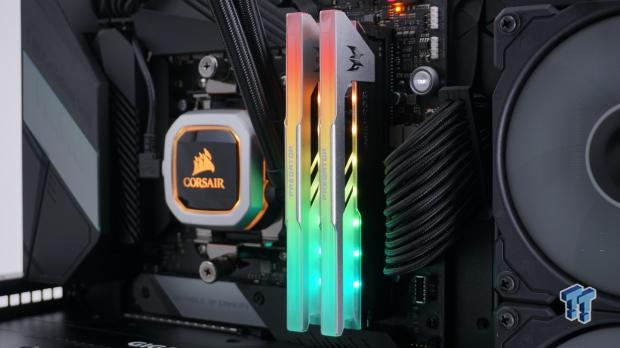
With the Predator Apollo RGB installed in our AMD system, with a gap between the sticks, we get to appreciate the metallic stickers on the sides of the diffuser bar, as well as all of that smooth-looking RGB illumination across the top. However, at certain angles, seven of the LEDs are visible just above the black portion of the heat spreaders.
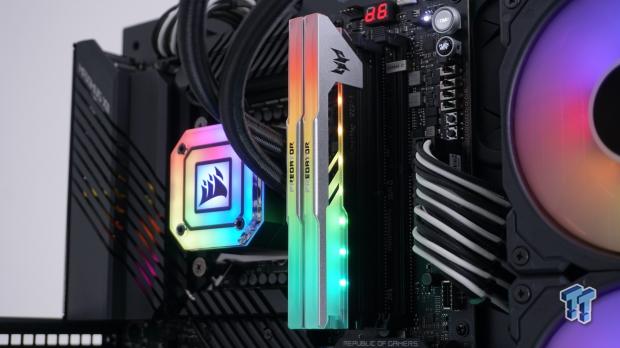
Our view of the Apollo RGB installed on the Intel system looks similar, but much closer together to each other looks better in our opinion. While the LEDs are still visible, the blending of colors through the diffuser bar is top-notch and should look fantastic when connected to RGB sync supporting motherboards.
Test System Details
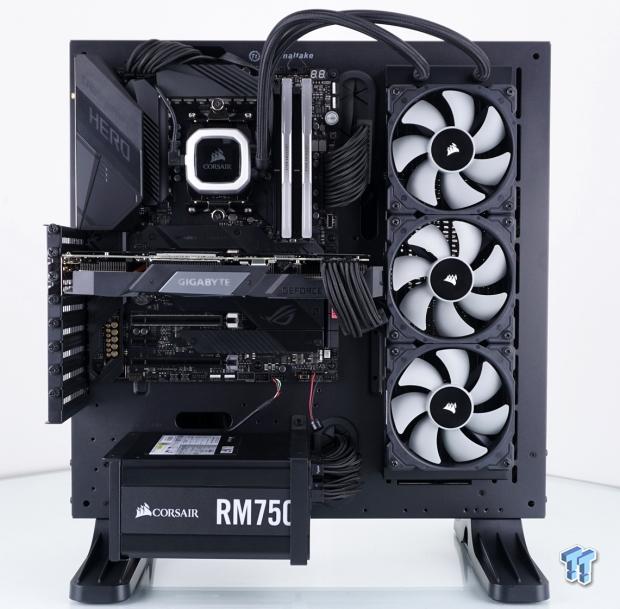
To obtain the AMD CPU-Z screenshots, you will see directly following this image, and this is the system we used to do it, as well as in attaining the results seen in the following pages. Thanks go out to Corsair, ASUS, and GIGABYTE for supporting this venture. Detailed specifications of the system can be found below.
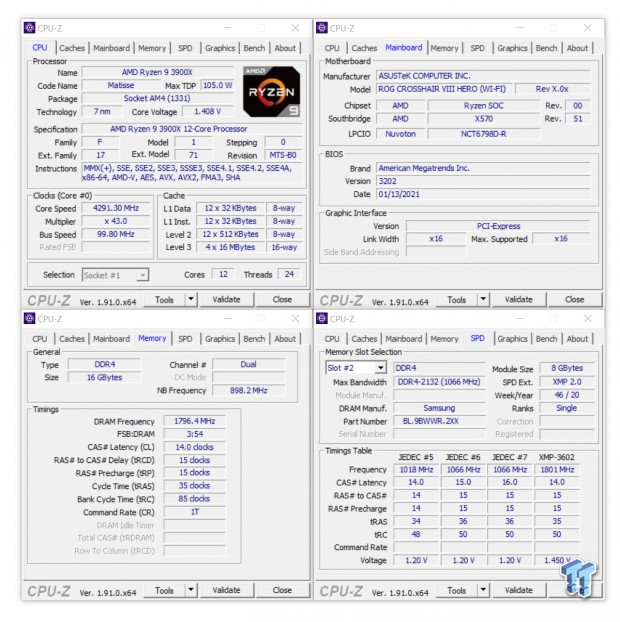
To enable DOCP, we first clear CMOS, installed these sticks, stopped off in the UEFI, enabled DOCP, saved, exited, and rebooted. After taking the screenshot of the 3600 MHz with 14-15-15-35 1T we see here, we popped back into the UEFI to verify voltages. We noticed that enabling DOCP did set the VDIMM to 1.45V, but our SOC was still set at just 1.088V.
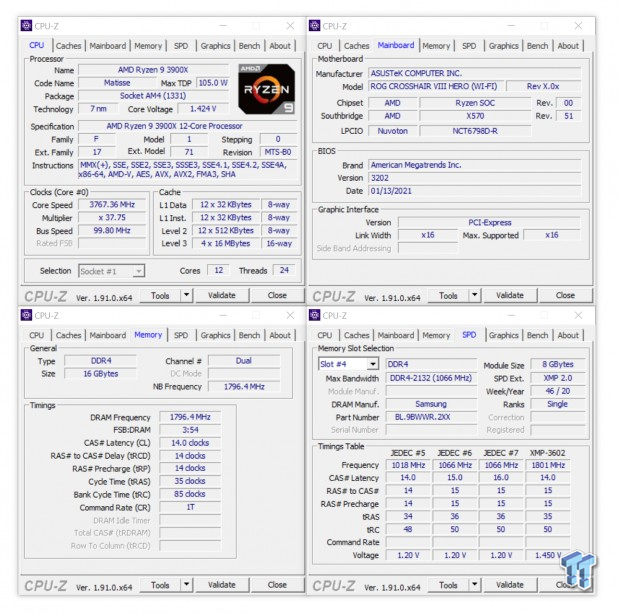
After all of the DOCP testing was finished, we bumped the VDIMM to 1.50V and increased the SOCK to 1.18125V to lower the timings. While we did not make tremendous gains, we had a strong suspicion that we could get those straight timings, and we could, as the CPU-Z shows the 3600MHz kit is now rolling with 14-14-1'4-35 1T timings. CAS13 was in no way stable.
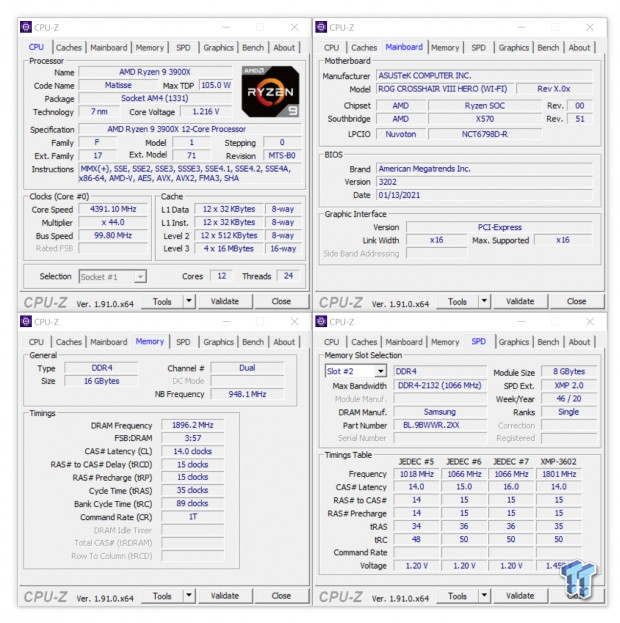
Keeping the voltages used to reduce the timings, we next switched gears to look for the top speed attainable, with reasonable voltages. In this pursuit, we ended up at 3800 MHz using the DOCP timings of 14-15-15-35 1T. Anything beyond this speed failed testing.
Chad's AMD DDR4 Dual-Channel Test System Specifications
- Motherboard: ASUS Crosshair VIII HERO Wi-Fi - Buy from Amazon
- CPU: AMD Ryzen 9 3900X - Buy from Amazon
- Cooler: Corsair H150i PRO - Buy from Amazon
- Video Card: GIGABYTE GeForce RTX 2060 SUPER Gaming OC 8GB - Buy from Amazon
- Storage: Corsair Force MP500 480GB NVMe - Buy from Amazon
- Case: Thermaltake Core P5 TG - Buy from Amazon
- Power Supply: Corsair RM750x 750-watt - Buy from Amazon
- OS: Microsoft Windows 10 Home 64-bit - Buy from Amazon
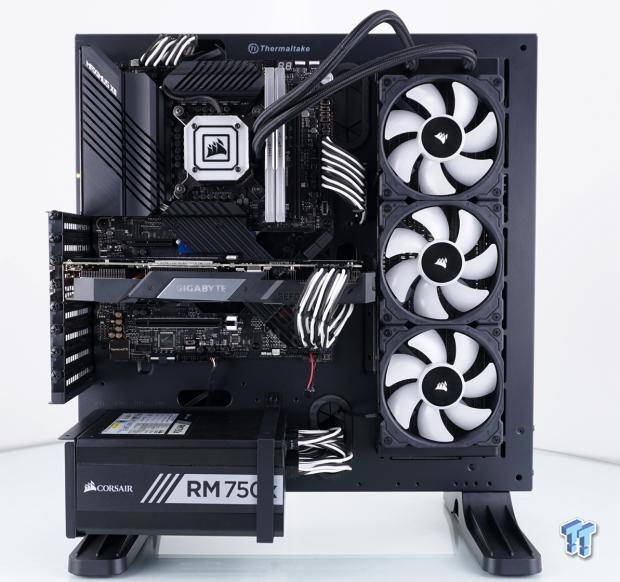
To obtain the Intel CPU-Z screenshots, you will see directly following this image, and this is the system we used to do it, as well as in attaining the results seen in the following pages. Thanks go out to Corsair, ASUS, and GIGABYTE for supporting us here too! Detailed specifications of the system can be found below.
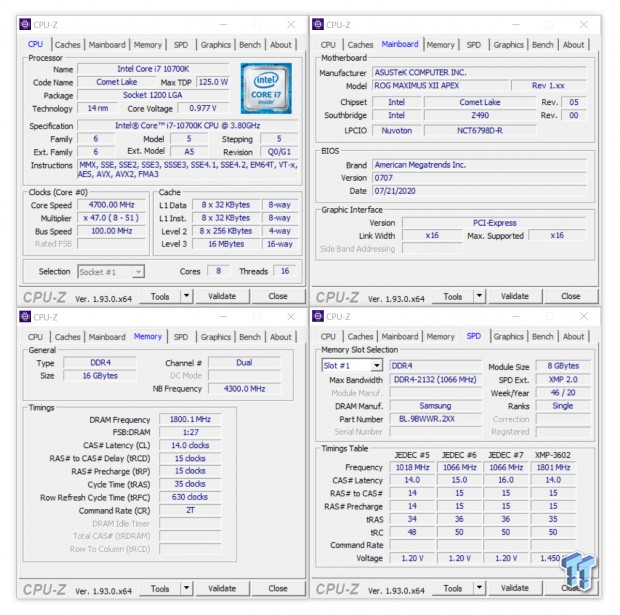
Using the same methodology we used with the AMD rig, we moved to the Intel system and started by clearing CMOS, stopping off in the UEFI to enable XMP 2.0, and then booting the PC. As expected, no issues were getting the Predator Apollo RGB to run at the rated speed and timings. A trip back to the UEFI showed us that the VDIMM was at 1.45V, the VCCIO was showing 1.312V, and the VCCSA was using 1.504V to do this.
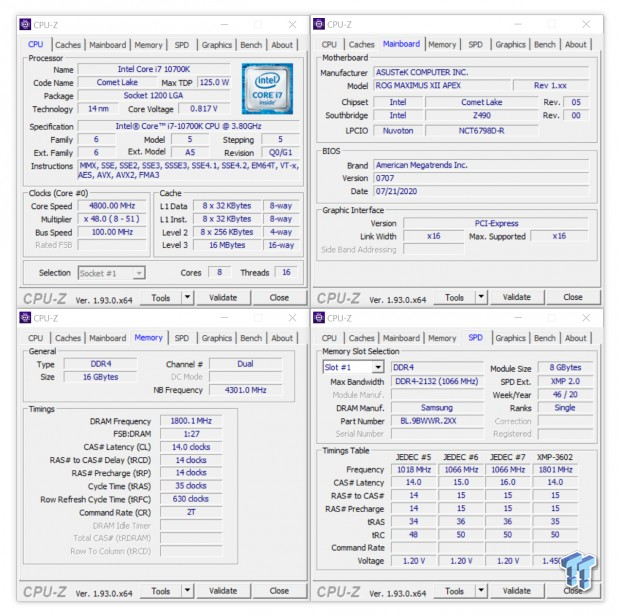
Since we felt that the VCCIO and VCCSA were high enough already, we only moved the VDIMM to 1.50V to see where the timings would end. Similar to the AMD testing, the Intel rig would not run anything lower than 14-14-14-35 2T but runs this as stable as can be.
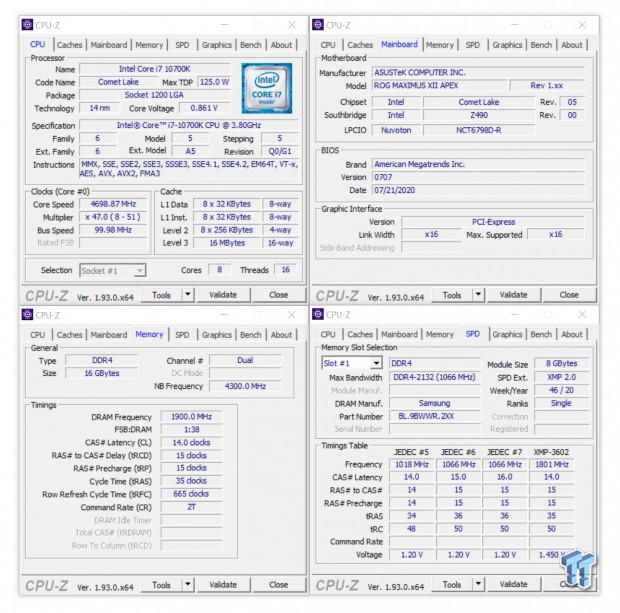
3800 MHz is also the top of the line for how the Predator Apollo reacted to the 10700K IMC. Leaving the voltages the same as the low-timing run, we could see the system post and run at idle at 3866 MHz, but it failed quickly under early test suites.
Chad's Intel DDR4 Dual-Channel Test System Specifications
- Motherboard: ASUS ROG Maximus XII Apex - Buy from Amazon
- CPU: Intel Core i7 10700K - Buy from Amazon
- Cooler: Corsair iCUE H150i Elite Capellix - Buy from Amazon
- Video Card: GIGABYTE GeForce RTX 2060 SUPER Gaming OC 8GB - Buy from Amazon
- Storage: Intel SSDPEK1W120GA
- Case: Thermaltake Core P3 - Buy from Amazon
- Power Supply: Corsair RM750 - Buy from Amazon
- OS: Microsoft Windows 10 Home 64-bit - Buy from Amazon
AMD Performance
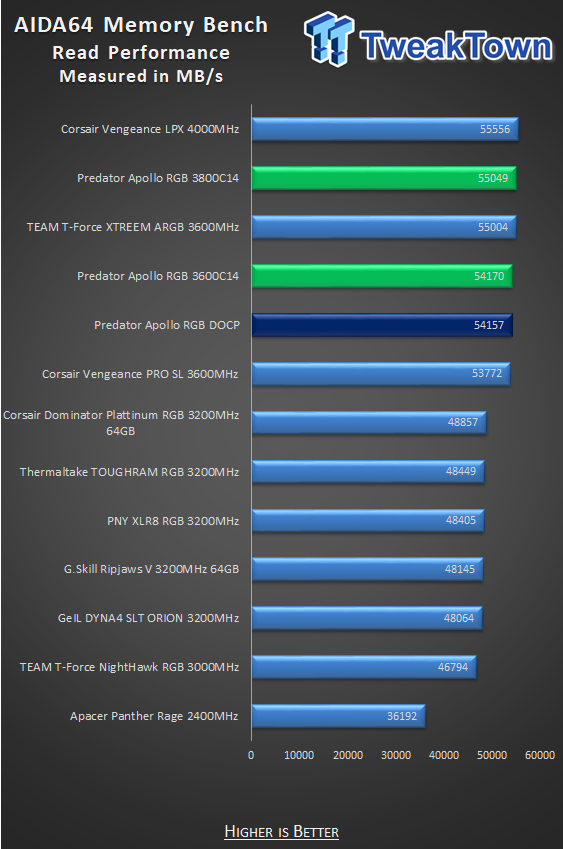
With the Predator Apollo RGB using the DOCP setting, we can see that only the LPX 4000 and the T-Force XTREEM show better in read performance. At 54157 MB/s, it blows past the Vengeance PRO SL results. Timings helped a touch, but only a few MB/s were gained. However, when bumping the speed 200 MHz, the effort gained us 892 MB/s over the DOCP run.
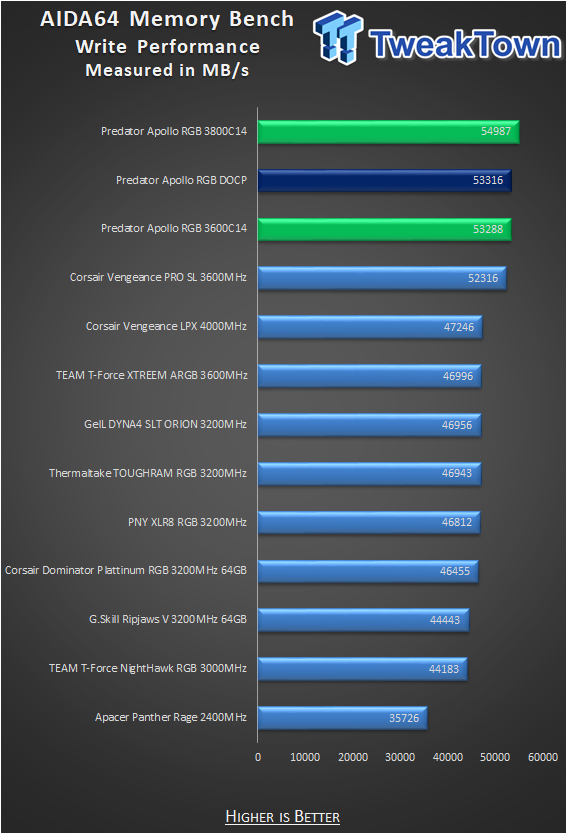
After seeing the read performance, we had high hopes for the write performance, and the Apollo RGB did not disappoint with their chart-topping results. 1000 MB/s faster than anything else on the chart is impressive, and while the slight drop in speed using 14-14-14 timings is a bit of a downer, that 1671 MB/s boost for 200 MHz more of speed is impressive.
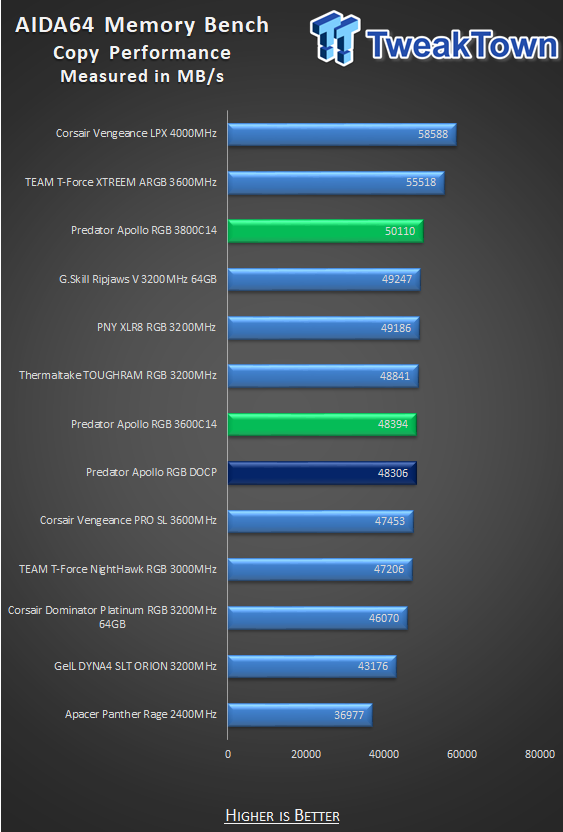
Losing to its direct competition in the XTREEM ARGB by quite a margin at just 48306 MB/s in copy performance is a letdown. Minimal gains were had with the timing change, and even with an extra 200 MHz over the XTREEM ARGB, the Apollo RGB fell short of impressing again.
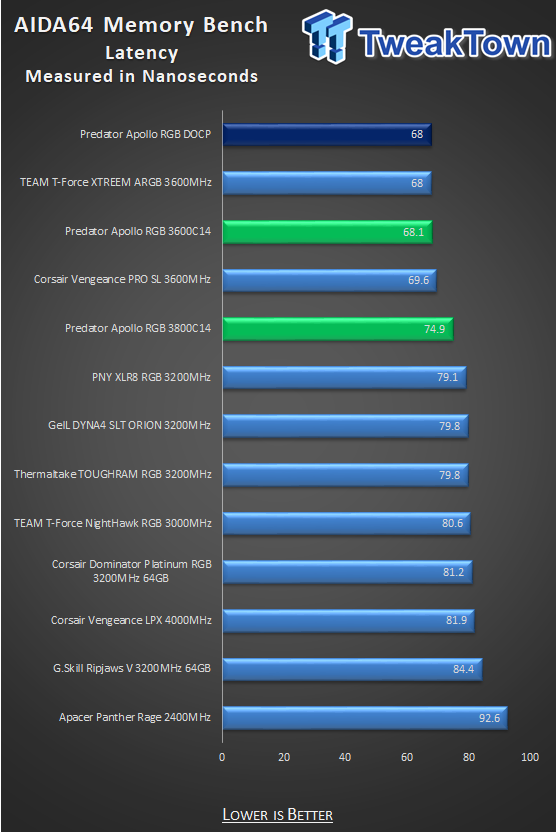
For those of you that live by the latency, the Predator Apollo takes top honors here at 68ns, tied with the XTREEM ARGB. We gained a tenth of a nanosecond using straight 14 timings and dropped even further down the chart opting for 3800 MHz speed.
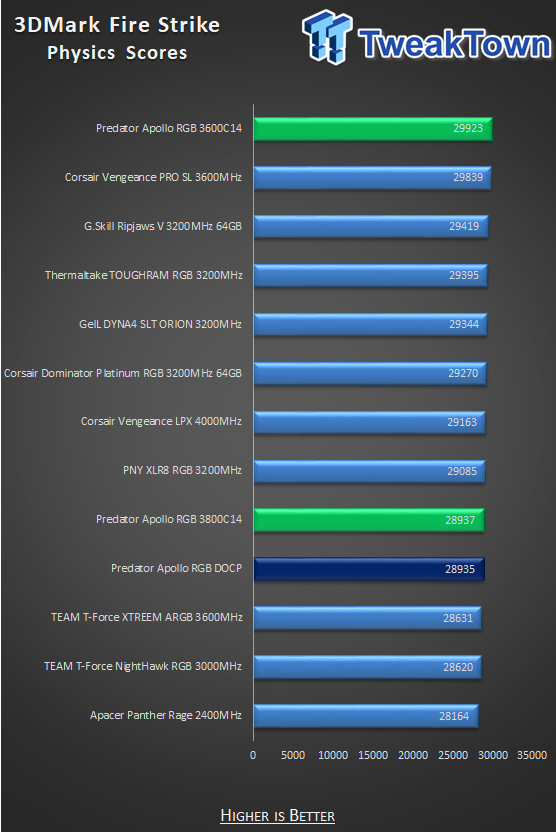
In our 3DMark Physics scores, we see that the Vengeance PRO SL ate the fastest kit for 3600 MHz results, and the Apollo RGB fall seven spots from them. We gained two points, increasing the speed to 3800 MHz, and almost shockingly took top honors with a very slight reduction to the secondary timings.
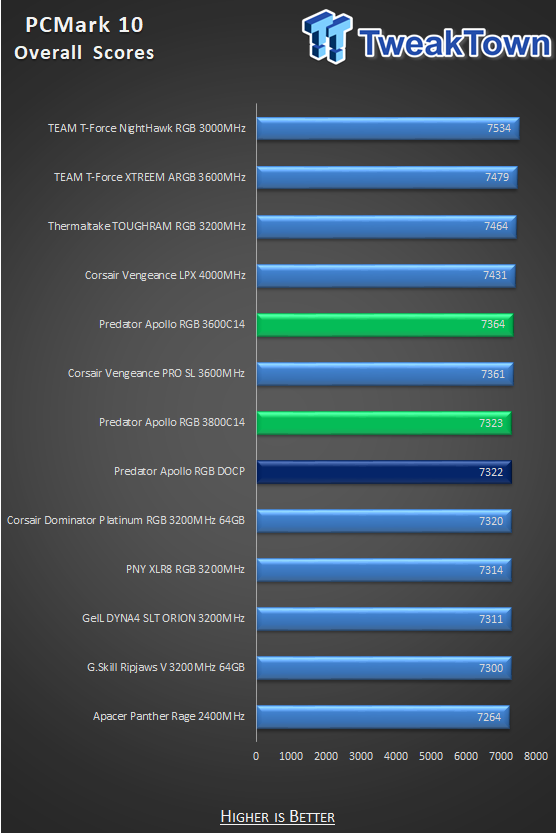
The PCMark 10 results show us that the Apollo RGB scores worse than both the XTREEM ARGB and the Vengeance PRO SL. The added speed gained us a single-point advantage while using 14-14-14 timings bumps the Apollo RGB up a slot by a 42-point gain over the DOCP run.
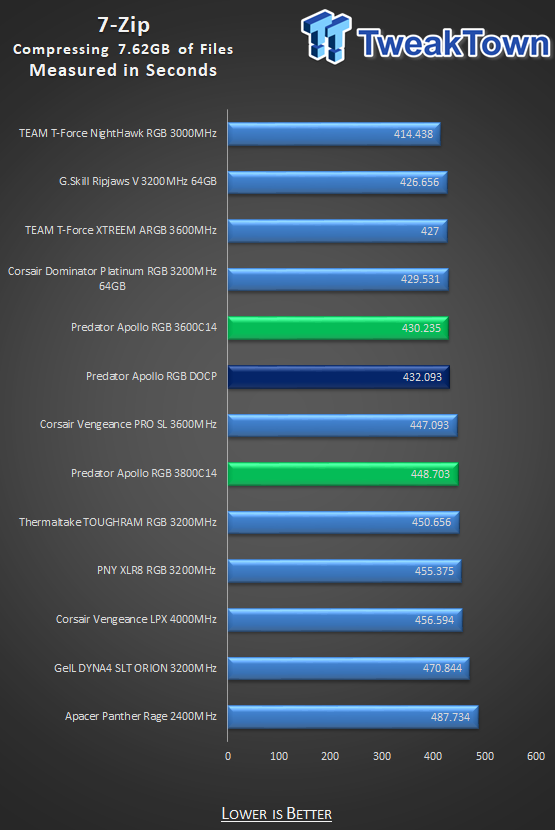
Fifth place overall for 7-Zip compression is a fair result, and of the 3600 MHz kits in the chart, Apollo RGB beats Corsair but is still bested by TEAM. Reducing timings gives us roughly two seconds of our life back for every 7.62GB of data being compressed, while more speed makes us pay a hefty penalty.
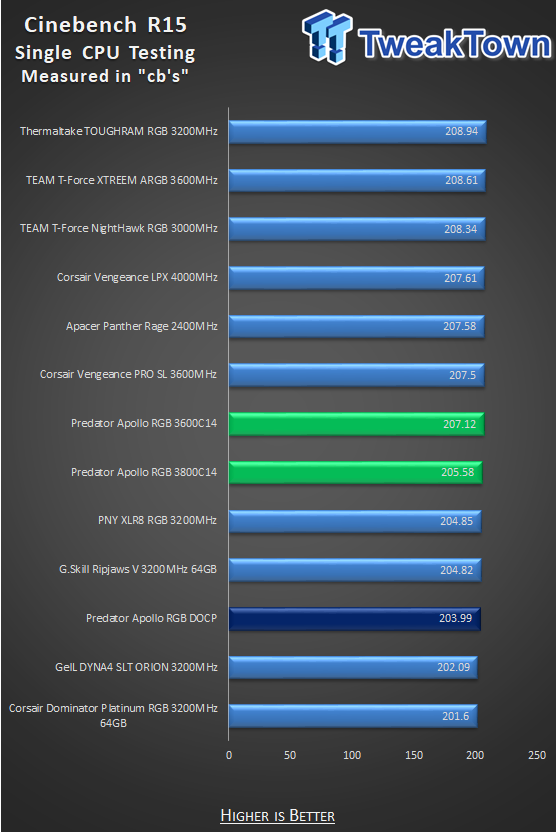
Cinebench R15 results show that the Apollo RGB is in no way geared to impress here with that 203.99 CB result at the bottom of the chart. Either way we overclocked this kit, it was still bested by Corsair and TEAM again.
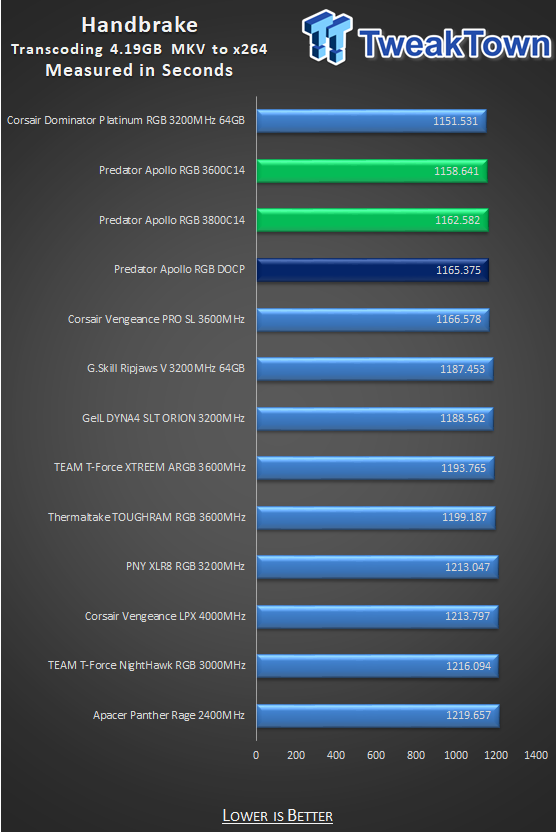
After seeing what we did with the Cinebench results, we figured when it came to transcoding that the Apollo RGB may falter, but as you can see, this is not the case. While the Corsair Dominator Platinum RGB kit still sits in first, anyway we ran the Apollo RGB in this metric results in a second-place position with slightly varying results, all within 6.7 seconds of each other.
Intel Performance
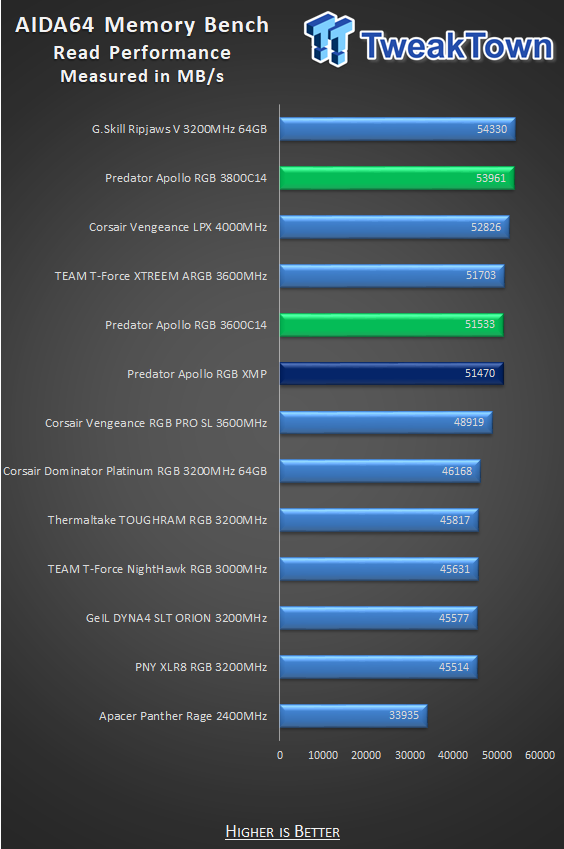
When paired with the 10700K, the read results in AIDA leave the Apollo RGB in fourth place while utilizing the XMP setting. Reducing timings gained us a little less than 100 MB/s boost, but an extra couple hundred megahertz in speed resulted in a second-place finish and an increase of roughly 2500 MB/s over XMP.
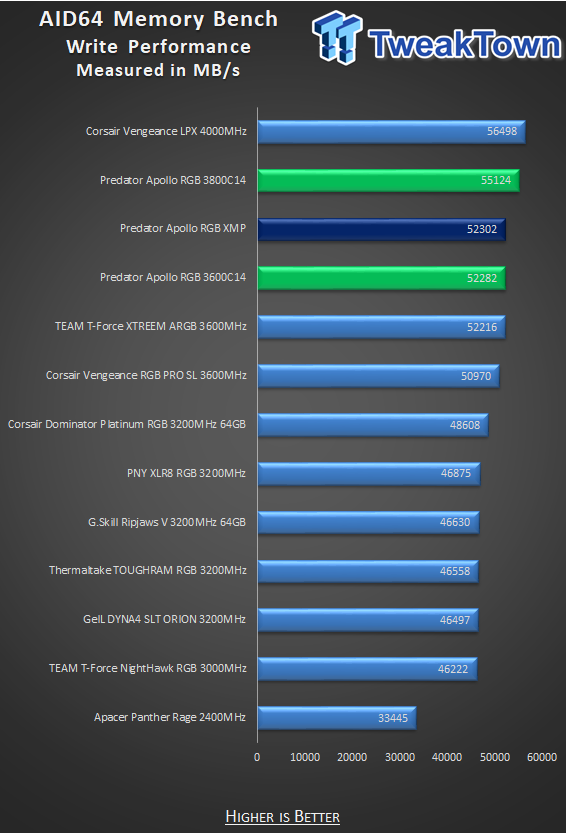
Any way you want to see it, the Apollo RGB takes second place, hands down, with its write performance. Only the 4000 MHz LPX bests this kit. At nearly 1100 MB/s faster than the EXTREME ARGB, XMP vs. XMP, the Predator handily beats its direct competition. We lost about 20 MB/s lowering the timings but gained a hefty 2822 MB/s opting to run them at 3800 MHz.
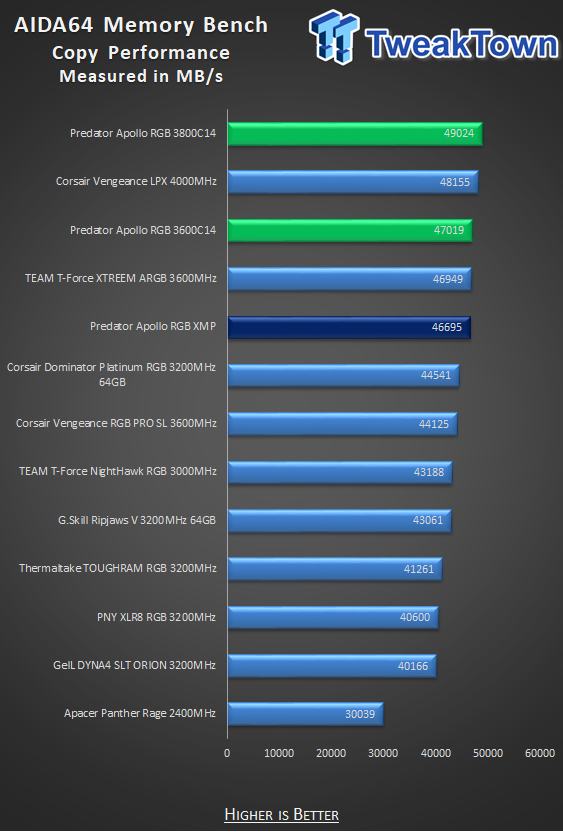
Even when it comes to copy performance, the Apollo RGB stands proud in our chart with a third-place finish, ever so slightly behind the EXTREME ARGB. Lowing the timings outperformed the XTREME ARGB by the slightest of margins, and that 2329 MB/s advantage over XMP by upping the speed is a nice bonus as well.
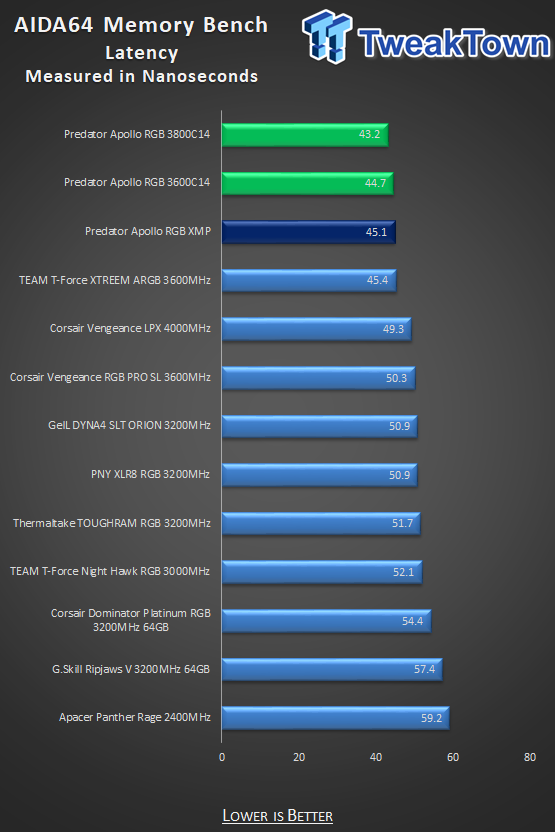
Latency is also impressive on the Intel system. At 45.1 ns, the Apollo not only beats the EXTREME ARGB, but it also settles at the top of the chart. The reduction of timings offers a slight decrease, but the added speed using CAS14 showed some of the best results we have ever seen.
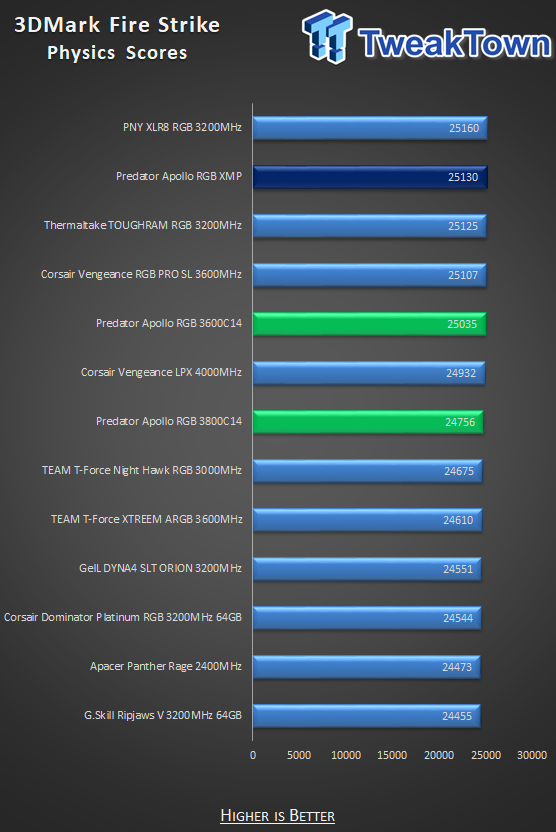
In this test, the AMD results were, well, a bit lower than we would have liked, but things are different when it came to our Intel testing. The Apollo ARGB delivered second-place results right out of the box, but sadly, no matter which way we fiddled with the RAM, we had to pay a penalty in this test.
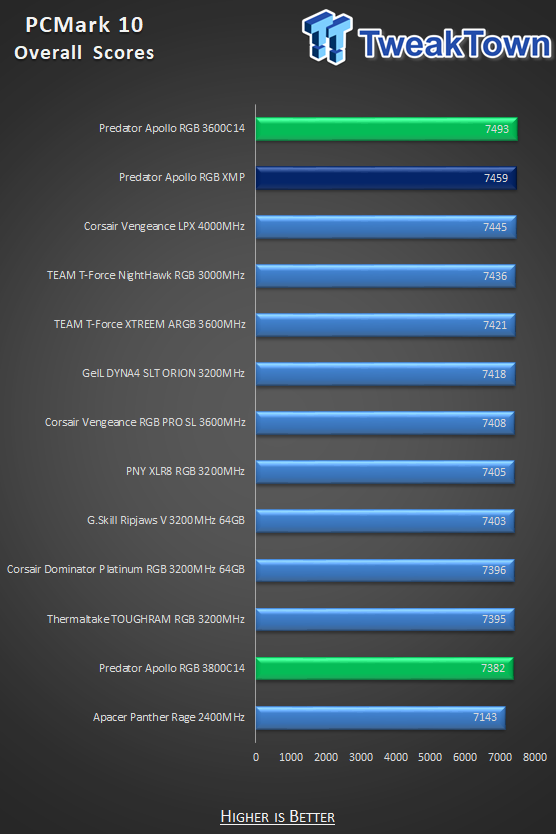
We are pleased to see that the Apollo RGB did so well in PCMark 10 here, while the AMD results were not nearly as promising. Running them under control of XMP resulted in a first-place finish in this chart, and while overall speed pushed it way down the list, swapping 15s for 14s in the secondary timings gave us the best scores.
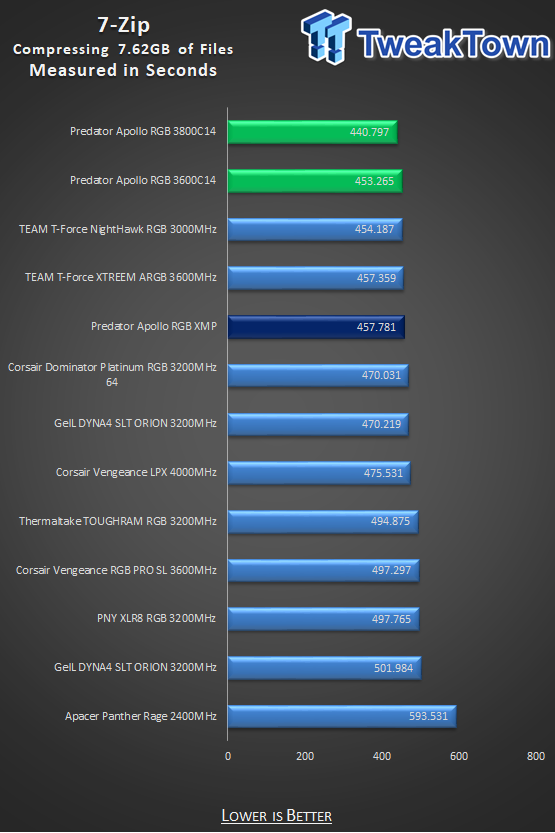
Here is yet another instance where the Apollo RGB seems better off in an Intel rig. Not only were the XMP results on par with the EXTREEM ARGB, but this time, we gained a bunch of time back in our day, opting for reduced timings and a much more considerable reduction when using this kit at 3800 MHz using XMP timings.
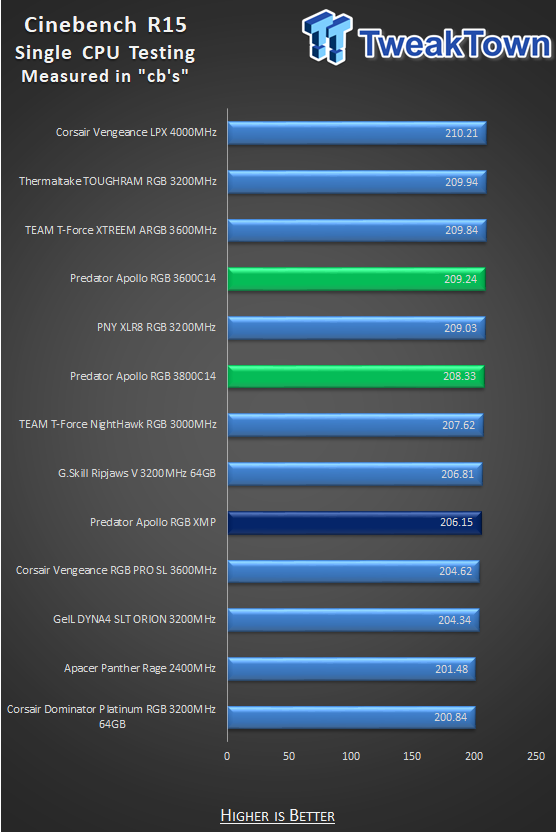
The XMP results are not third from the bottom like we saw with the AMD-based PC, but the fifth from the bottom is not much better. However, we gained much more traction in this chart by running 14-14-14-35 timings at 3600 MHz than we saw with AMD, and not far behind are the 3800C14 results.
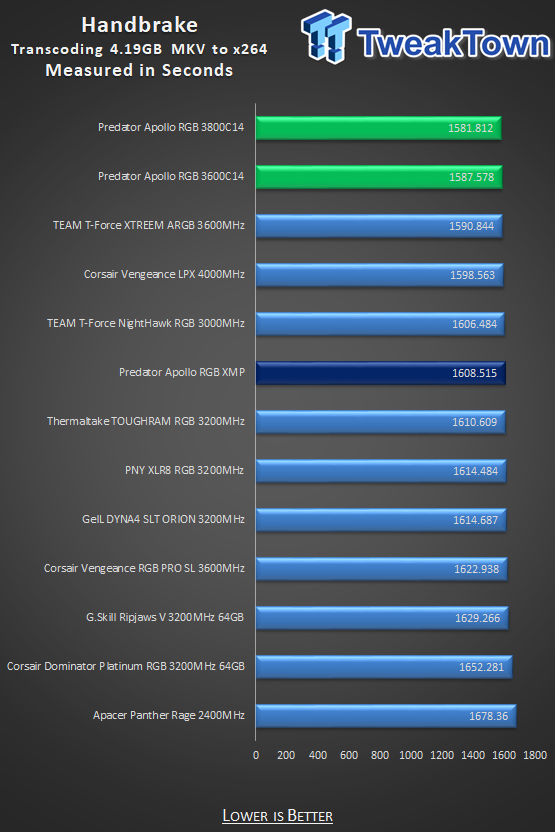
Handbrake with Intel is a slightly different story as well. Rather than all three results filing into second place, this time, we see that the XMP profile delivers a fourth-place finish. Opting to reduce the timings gained us another 20 seconds, and increasing speed gained back another six seconds on top of that, both options landing at the top of the chart.
Final Thoughts
When it comes to appearance, love them or hate them, they are original looking, and in our opinion, are quite the lookers. The mix of matte black aluminum at the bottom with the silver side bits, all wrapped around the tall diffuser, there isn't a single bit about it we did not like. Lighting can be left as they are shipped, which has lighting running through a rainbow of colors, starting from the top and running down each stick. For those looking to match the rest of the build, you will need to employ motherboard sync of some sort, as we did not see any software provided by Predator.
Although, with the overall height a bit more than 50mm, it can cause clearance issues with the larger air coolers out there. Nevertheless, when it comes to a company and their first attempt at RGB DDR4, we feel that Predator is on the right path.
Performance is a mixed bag. While some of the AMD results were fantastic, we do feel, that on average, the Apollo RGB is geared more towards Intel systems, and we have the results to prove that. This opinion is based on just the XMP vs. DOCP results. As much as we love to clock memory, as you can see in our charts, most times it has rewards, but there are times where you will pay a significant penalty as well. Continuing on this matter, we feel that if you are like us and like to tinker in the UEFI with RAM, tertiary timings are where you will gain more performance on AMD.
While we saw some impressive things with our 3900X, those systems would be better off with the TEAM version it traded blows with along the way. If we had to pick whether to use the XTREEM ARGB or these Apollo RGB, it would require a coin flip with the Intel system. They are so evenly matched that we feel it would come down to appearance and compatibility with the rest of the system.
What we do know is that 3600 MHz CAS14 kits of B-die are getting to be as rare as hen's teeth these days, and when you do find them, they are going to set you back with their premium pricing. Funny enough, whether opting for the Apollo RGB we just looked at or the XTREEM ARGB, they cost the same, and what boggles our minds is why this Predator RAM is so hard to find for sale. That one fact alone will likely have you wandering the listings looking for another maker's version of 3600C14 DDR4, based on availability alone.
Even though we have no complaints about what we saw, and the better than average results average out to something, that while not an outstanding best of anything specific, they are sticks that will be not only a visual upgrade but bring a good amount of performance along with them. With the fact that the MSRP is set at $249.99, you are either an overclocker who wants anything B-die related or is someone who falls in love with the visual appeal. There is no disrespect to Predator or their Apollo RGB, but at this price range, we feel that many customers will gravitate to TEAM, Corsair, or G.Skill when looking for 3600 MHz kits with tight timings.
Performance |
96% |
Quality |
100% |
Features |
95% |
Value |
98% |
Overall |
97% |
Predator comes out of the gate hot! Our first look into their Apollo RGB impressed us. Not only is it visually striking, and something many would be proud to add to a build, but based on B-Die ICs, and tight timings, delivers the performance we expected as well.

What's in Chad's PC?
- CPU: Intel Core i7 13700K
- MOTHERBOARD: ASUS ROG Maximus Z690 Hero Eva
- RAM: TEAM DDR5-7200 32GB
- GPU: ASUS GeForce RTX 3090 Eva
- SSD: addlink m.2 2TB
- OS: Windows 11 Pro
- COOLER: Fractal Lumen S36
- PSU: be quiet! Dark Power Pro 1500W
- KEYBOARD: ASUS ROG Strix Scope TKL Electro Punk
- MOUSE: ASUS ROG Strix Impact Electro Punk
- MONITOR: ASUS ROG Swift OLED PG42UQ
Similar Content
Related Tags

